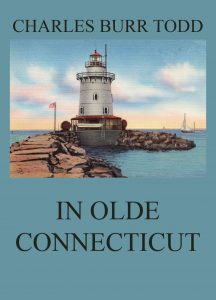In Olde Connecticut – Charles Burr Todd
The byways of history often have a fascination denied to the highroads. In these interesting pages Mr. Todd discourses pleasantly on various episodes in the past of an old England commonwealth. He takes us to Fairfield, to Lebanon, to New London, and gives us glimpses of matters not often set down. The picturesque side of our history is too often neglected. Even the strenuous resistance of the colonists to political and religious ideals they did not like did not deprive their lives of all salt and savor. There were dinners and dances at Lebanon, the home of Trumbull, when the French officers were there, and “the fair Connecticut girls” were considered attractive by the visitors. Here is an engaging record of the “unconsidered trifles, curious episodes, bits of quaint and curious lore” which the author had succeeded in rescuing from unworked mines of local tradition and chronicle.
Format: Paperback.
In Olde Connecticut.
ISBN: 9783849672379.
Available at amazon.com and other venues.
Some basics on Connecticut (from Wikipedia):
Connecticut is the southernmost state in the New England region of the northeastern United States. As of the 2010 Census, it has the highest per-capita income, Human Development Index (0.962), and median household income in the United States. It is bordered by Rhode Island to the east, Massachusetts to the north, New York to the west, and Long Island Sound to the south. Its capital is Hartford and its most populous city is Bridgeport. It is part of New England, although portions of it are often grouped with New York and New Jersey as the Tri-state area. The state is named for the Connecticut River, a major US river that approximately bisects the state. The word “Connecticut” is derived from various anglicized spellings of an Algonquian word for “long tidal river”.
Connecticut’s first settlers were Dutchmen who established a small, short-lived settlement called Fort Hoop in Hartford at the confluence of the Park and Connecticut Rivers. Half of Connecticut was initially part of the Dutch colony New Netherland, which included much of the land between the Connecticut and Delaware Rivers. The first major settlements were established in the 1630s by the English. Thomas Hooker led a band of followers overland from the Massachusetts Bay Colony and founded the Connecticut Colony; other settlers from Massachusetts founded the Saybrook Colony and the New Haven Colony. The Connecticut and New Haven colonies established documents of Fundamental Orders, considered the first constitutions in North America. In 1662, the three colonies were merged under a royal charter, making Connecticut a crown colony. This was one of the Thirteen Colonies that rejected British rule in the American Revolution.
Connecticut is the third smallest state by area, the 29th most populous, and the fourth most densely populated of the 50 states. It is known as the “Constitution State”, the “Nutmeg State”, the “Provisions State”, and the “Land of Steady Habits”. It was influential in the development of the federal government of the United States.
The Connecticut River, Thames River, and ports along the Long Island Sound have given Connecticut a strong maritime tradition which continues today. The state also has a long history of hosting the financial services industry, including insurance companies in Hartford and hedge funds in Fairfield County.
(The text of the last section was taken from a Wikipedia entry and is available under the Creative Commons Attribution-ShareAlike License.)
Publisher’s Note: This book is printed and distributed by Createspace a DBA of On-Demand Publishing LLC and is typically not available anywhere else than in stores owned and operated by Amazon or Createspace.

